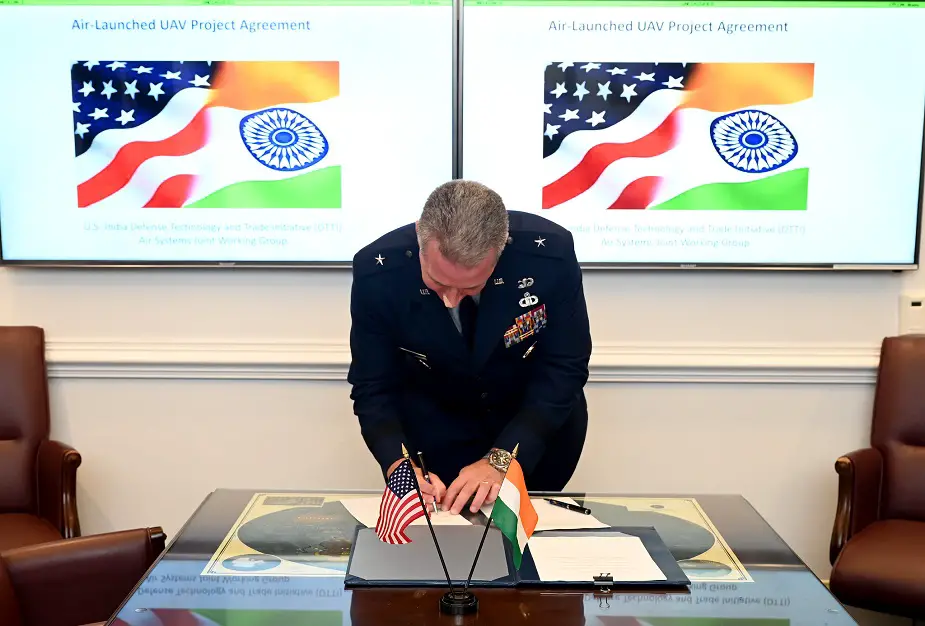Breaking news
India and US sign project agreement for air-launched UAV.
Under the auspices of the U.S.-India Defense Technology and Trade, the U.S. Air Force has signed an agreement for joint development of Air Launched UAVs with India’s Defence Research and Development Organization. The milestone agreement is the first such technical project agreement under the DTTI for joint cooperative research and co-development activities. The DTTI, which began in in 2012, aims to utilize both countries’ top-tier capabilities, talent and resources to jointly develop defense technology as part of a growing bilateral defense partnership.
Follow Air Recognition on Google News at this link

Cochair of the US-India Defense Technology and Trade Initiative, Brig. Gen. Brian Bruckbauer signs the Air Launched UAV Co-Development Agreement at the Pentagon, Arlington, Va., July 16, 2021 (Picture source: US Air Force)
Under the new seven-year, $22.3 million project, which focuses on cooperation in science and technology, the Air Force Research Laboratory will team with scientists and engineers from the DRDO, the S&T arm of the Indian Ministry of Defence, to design, develop and build a new Air-Launched Unmanned Aerial Vehicle for Under-weather and Stand-off imaging and Extended Range Communication.
The first phase is the design proof of concept, followed by the development of new ALUAV system to meet operational requirements. U.S. DoD tasks account for 50 percent of the agreement and the total project doubles the value of ongoing cooperative work with India.
Brig. Gen. Brian R. Bruckbauer, the former Director of the Air Force Security Assistance and Cooperation Directorate for the Air Force Life Cycle Management Center who retired in August 2021, and Air Vice Marshal Narmdeshwar Tiwari, Indian Air Force, Assistant Chief of Air Staff for Plans, signed the agreement in July.
“This important project agreement comes after many months invested by the AFSAC team, AFRL, Air Force International Affairs, the Office of the Under Secretary of Defense for Acquisition and Sustainment, as well as our Indian Air Force and DRDO counterparts working together, side-by-side, on common national security interests,” Bruckbauer said. “I am proud of the dedicated teamwork and partnership this Project Agreement represents for both of our countries.”
AFRL Executive Director Timothy Sakulich, who first interacted with DRDO in his role as executive- level champion for the India country portfolio as the director of AFRL’s Materials and Manufacturing Directorate, called India an “important partner” and said this agreement is “an exciting opportunity to deepen our relationship through collaborative technology development.”
The United States designated India as a Major Defense Partner in 2016. A shared commitment to ensuring a Free and Open Indo-Pacific Region underpins the growing defense partnership.
Sakulich noted the importance of this region while affirming our country’s "desire to build partnerships and strengthen relationships” as part of a “whole-of-nation” approach. “Projects like this help advance interoperability of our respective Air Forces, strengthen industrial base capabilities in areas of mutual interest, and contribute to broader capabilities that support shared regional goals,” he said. “S&T can be a contributor to building stronger relationships.”
Dr. Paul Fleitz, AFRL Air-Launched Off-Board Operations team lead, serves as the technical project officer.
“The UAS we develop [under this agreement] will ultimately launch from host aircraft to provide additional capability to the military,” he explained. The team will “start from the ground up to build a UAS designed for extended range communications, one capable of sending messages hundreds of miles.”
Stephen Dorff, an AFRL foreign affairs specialist, said that cooperative S&T efforts enable the lab to solve engineering and technical challenges in a more cost effective manner, delivering benefits to both countries.
“By sharing the costs and working together, we can accomplish engineering challenges while saving Indian and American taxpayer money,” he said.
Dorff highlighted the strategic importance of India to the DoD, emphasizing how cooperation and collaboration in S&T helps to deepen bilateral partnerships.
“International partnerships are key for strategic reasons … they enable us to build relationships and address technical considerations,” said Dorff.
Sakulich noted, “Diversity in perspectives and technical approaches can be a powerful source of innovation so there is a real value of these international partnerships in being a catalyst for new ideas and solutions.”
In 2017, AFRL officials discussed various ideas for collaborative S&T projects that would strengthen the capabilities of our Air Forces. Fleitz noted that DRDO’s expertise in UAS helped to solidify this area of interest. In the end, the U.S. and India will co-own the new UAS design.
To prepare for this cooperative project, Fleitz worked with representatives from across AFRL including those from the Aerospace Systems Directorate, Materials and Manufacturing, Sensors and the 711th Human Performance Wing.
“A UAS has all of these systems in it, just like a car,” he said highlighting “the propulsion, the drive train, the sensors . . . so that’s why we are bringing in a wide range of experts who will develop the plans,” he said.
The AFRL team is currently supporting technical meetings and will outline specific plans after the official kickoff meeting, currently slated for October.



















